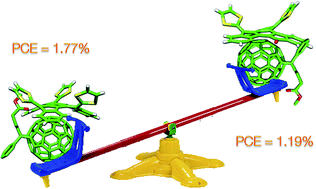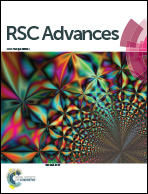Organic solar cells based on bowl-shaped small-molecules†
Abstract
The light absorption ability and morphology of the active components are two of the key factors that determine the energy conversion efficiency in organic solar cells (OSCs). Determining the relative importance of each of these aspects is decisive for the construction of more efficient OSCs. Here we introduce two π-extended derivatives of tetrathiafulvalene as electron donors for solution-processed small-molecule bulk-heterojunction solar cells. Both of them exhibit similar bowl-shaped geometry, excellent electron-donor characteristics and relatively large association constants with fullerenes in solution (on the order of 104 M−1 for truxTTF and 103 M−1 for truxTTF-CO in several solvents at room temperature). The substitution of one dithiole ring in truxTTF-CO for a carbonyl results in an intramolecular push–pull effect, which enhances its light-harvesting properties, with the onset of absorbance reaching 650 nm. The introduction of a third dithiole ring, results in a more pronounced concave shape in truxTTF, allowing a better self-assembly with fullerenes which in turn leads to a more favourable morphology. However, the light-absorption ability of truxTTF is limited to ca. 500 nm. We prepared bulk-heterojunction solar cells using phenyl-C60-butyric acid methyl ester (PC61BM) and PC71BM as electron-acceptors and bowl-shaped truxTTF and truxTTF-CO as electron-donors. The devices prepared utilizing truxTTF performed significantly better (PCE up to 1.77% with PC71BM and 0.92% with PC61BM) than the truxTTF-CO counterpart (PCE up to 1.19% with PC71BM and 0.56% with PC61BM).


 Please wait while we load your content...
Please wait while we load your content...